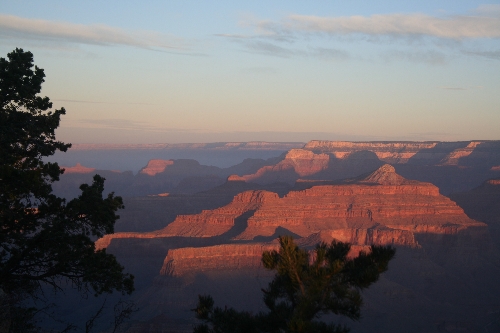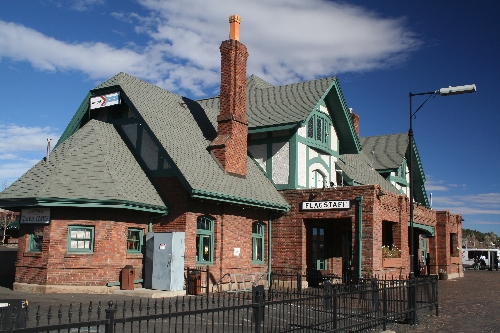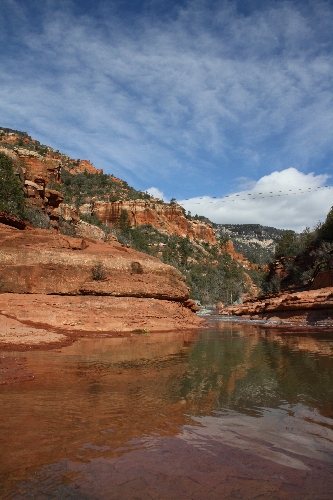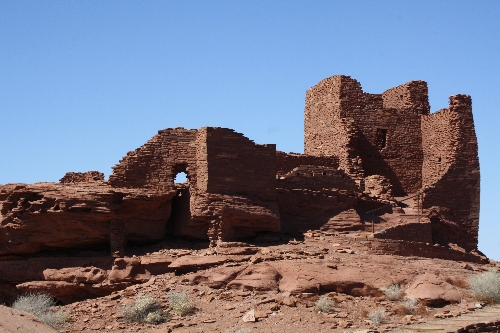Flagstaff makes a good home base when exploring Northern Arizona
A good way to see the scattered but fascinating sights of Northern Arizona is to establish a base camp among Flagstaff's comforts and conveniences, making daily sallies to surrounding points of interest.
From there, many of Arizona's must-see destinations lie in easy reach, so operating from that home base recently allowed a friend and me to enjoy a surprising number of sights in just three days. By day, we visited Grand Canyon National Park, hiked the red rocks at Sedona, explored three national monuments and, on the way home, took in the view along a 100-mile segment of Route 66. By night, we took in Flagstaff's varied nightlife and restaurants.
Flagstaff lies at a lofty elevation of about 7,000 feet, so late spring and summer temperatures remain relatively cool, a perfect time to set out for day trips in the surrounding area. Average high temperatures in May are close to 70 degrees and are around 80 degrees in June, July and August.
Driving from Las Vegas, we turned north out of Williams, a straight shot up to the south rim of the Grand Canyon. Although we have visited the canyon dozens of times before, being so close by we felt it was a great place to start, even if we only had a couple of hours to spend there. We walked along a segment of the rim trail taking in the views.
After getting our canyon fix, we headed back south toward Williams, but then veered east on U.S. 180, a good back road for a shorter and scenic route to Flagstaff. This road travels through an especially appealing region of the 1.8-million acre Coconino National Forest and includes driving through the largest contiguous ponderosa forests in the world. As you come into town, you will pass close by the base of the San Francisco Peaks, home to Arizona's highest, 12,633-foot Mount Humphrey.
It was late afternoon when we arrived in Flagstaff and checked into the Monte Vista Hotel, in the town's historic district. If you like hotels steeped in folklore, this is a good one. Built in 1927, the four-story brick hotel was the most sought-after accommodation in Northern Arizona for Hollywood's stars during the 1940s and 1950s. More than 100 movies were shot in the surrounding region during those years, so Humphrey Bogart, Spencer Tracy, John Wayne, Bob Hope and Clark Gable all chose the Monte V, as it's known, as their quarters.
After settling in, we set out to explore the historic district, which was full of activity even though it was a weekday evening. We walked around looking over many buildings, many built in the 1890s when Flagstaff was just getting started as a lumber and railroad town. Flagstaff is also home to Northern Arizona University, so the area was alive with young people and the kind of businesses they patronize. Within a few blocks of our hotel we found microbreweries, art galleries, shops and restaurants and diverse nightly entertainment.
One thing you'll notice straight away while visiting Flagstaff is the trains, which still roar through town at all hours.
Back at our hotel for the night, we remembered that many guests, including John Wayne, have reported ghost sightings and other paranormal behavior at the Monte V. One of the most common occurrences reported is people hearing a knocking at their door, followed by a muffled voice announcing "room service." But when the guest opens the door, no one is there. Wayne said he saw the ghost, who was a young boy and seemed friendly.
Starting at 2:45 a.m., we heard a constant knocking at the door to the next room. No one seemed to answer, and the knocking progressed down the hallway, trying every door. I lacked the courage to open the door to a stranger at 2:45 a.m., and cannot say whether it was the phantom bellboy or some living mortal confused about which room to enter.
The next morning, we set out soon after first light and headed south on a twisty and dramatic drive through Oak Creek Canyon to Sedona, the popular resort that emerged in the past few decades about 27 miles from Flagstaff.
Sedona is itself a good place to stay while exploring the surrounding attractions and is noted for luxurious accommodations. Even if you are base-camped in Flagstaff, Sedona is worth a side trip to visit some of the best art galleries in the Southwest and the spectacular red-rock scenery. We took a short hike up to one of the finer views of the town, high up on a rock outcropping on the road up to the local airport. After, we stopped in at Slide Rock State Park and walked upstream. This was the Pendley Homestead, a historic apple farm before it became a state park. Most people come here to swim along a one-half mile section of Oak Creek, but the highlight here, especially for children, is sliding down the 80-foot natural sandstone water chute. This is a lot of fun, but the crowds in summer are notorious. The best time to visit is midweek and before school lets out for summer.
Doing our best to pack a lot of experiences into our day, we headed back up Oak Creek Canyon to Flagstaff and then east about 10 miles to the 3,600 acre Walnut Canyon National Monument. The highlight of the park is the prehistoric cliff dwellings built by the people archeologists call Sinagua. The Sinaguans resided in rooms they built into the canyon's natural limestone alcoves. They lived here from around 1150 to 1300 A.D., hunting and farming, before they apparently moved on. The ideal way to enjoy this park is taking the Island Trail, a steep one-mile loop trail that descends into the canyon a couple of hundred feet to "The Island," a natural promontory created by Walnut Canyon's meandering stream.
From this point, our next destination was about 20 minutes away just northeast of Flagstaff: the 3,040-acre Sunset Crater Volcano National Monument. Experts believe this is the youngest volcano on the Colorado Plateau, where eruptions occurred between 1040 and 1100. Driving through the park will give a satisfactory view of the 1,000-foot-high cinder cone, but taking a walk down the Lava Flow Trail will enhance the visit. Traveling through lava flows and cinder barrens, this short trail is a one-mile loop.
In 1929, there was a plan to dynamite the cinder cone, to create a landslide scene in the Hollywood movie "Avalanche." Word leaked out, putting citizens into an uproar. They managed to "defuse" the dynamite idea and got the area named a national monument in 1930.
Just down the road, we entered Wupatki National Monument, one of the best places to see prehistoric pueblo dwellings. The 56-square-mile park boasts about 2,700 archaeological sites. The most impressive is Wupatki Pueblo, just outside the park's visitor center. We took a self-guided walking tour. The pueblo was built around a red sandstone outcropping and has about 100 rooms and is three-stories high. Excavations have shown this was occupied by about 100 people, now known as northern Sinaguans, from about 1180 to around 1225. It was once the largest structure for at least 50 miles.
Within a short walk from the pueblo is a ballcourt, 105 feet long and 64 wide, surrounded by walls about 4½ feet tall. It resembles ones built by the Hohokam to the south but is unique, the only stone masonry ballcourt found to date in Arizona. No one is certain how the people who built it used ballcourts. They might have been used for athletic contests similar to our own, ceremonies or some kind of social event.
Nearby we found a natural "blowhole," an opening into a tunnel said to equal an airspace 165 feet square and 50 miles long. The hole blows air out or sucks it in, depending on weather conditions. We visited while a low-pressure system was passing over, so the air blew out of the hole, and rather strongly. There's a grate over the hole making it safe to lean over it, so visitors typically get the longest-haired member of the party to do so, making the tresses billow on the emerging breeze. It makes a good photo.
If you are interested in learning more about our American Indians, the Museum of Northern Arizona has several events this spring and summer. The 21st Annual Zuni Festival of Arts and Culture takes place May 28-29, the 78th Annual Hopi Festival of Arts and Culture July 2-3 and the 62nd Annual Navajo Festival of Arts and Culture runs August 6-7. These events feature ancient and modern cultural presentations from dance and music to art and food, giving visitors an authentic look into these interesting cultures.
We finished our day by getting some food and drink at the microbrewery and then headed over to the Hotel Weatherford to listen to live jazz at Charly's Pub. The pub is located on the second level of the hotel and features two rooms, one with a cozy fireplace, and outdoors there is a porch that wraps around the establishment.
The next morning, we headed west and on our way home. We headed off the interstate in Ash Fork onto Route 66. Once Interstate 40 came along, this section from Ash Fork to Kingman became an uncrowded route, and we found it an especially good place to see some wildlife. Along the way, we were treated to seeing a bald eagle and a pronghorn antelope. We stopped in at Grand Canyon Caverns and took a 45-minute tour. This is the largest dry canyon in the United States and well worth the fright of taking an elevator 22 stories deep into it. I hadn't been there in a few years and was surprised to find out they now have a place where you can stay the night in the cavern in what they bill as "the largest, oldest, deepest darkest, quietest motel room in the world."
I was enchanted by the "Clan of the Cave Bear" novels and have always wondered what it would be like to be a cavewoman. But I'll save that experience for another trip. For this one, I was very satisfied to overnight in Flagstaff.




















